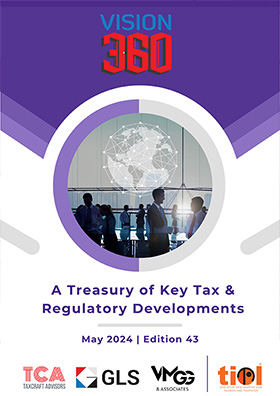Cabinet approves revamped Gold Monetisation Scheme and Gold Bonds Scheme as promised in Budget 2015
By TIOL News Service
 |
NEW DELHI, SEPT 09, 2015: THE Union Cabinet today okayed the much-delayed Gold Monetisation Scheme (GMS) and also the introduction of Gold Bonds Scheme as promised in the Budget 2015.
The objective of introducing the modifications in the schemes is to make the existing schemes more effective and to broaden the ambit of the existing schemes from merely mobilizing gold held by households and institutions in the country to putting this gold into productive use. The long-term objective which is sought through this arrangement is to reduce the country's reliance on the import of gold to meet domestic demand.
GMS would benefit the Indian gems and jewellery sector which is a major contributor to India's exports. In fiscal year 2014-15, gems and jewellery constituted 12 per cent of India's total exports and the value of gold items alone was more than USD 13 billion (provisional figures).
The mobilized gold will also supplement RBI’s gold reserves and will help in reducing the government's borrowing cost.
The revamped Gold Deposit Scheme (GDS) and the Gold Metal Loan (GML) Scheme involves changes in the scheme guidelines only. The risk of gold price changes will be borne by the Gold Reserve Fund that is being created. The benefit to the Government is in terms of reduction in the cost of borrowing, which will be transferred to the Gold Reserve Fund.
Collection, Purity Verification and Deposit of Gold under the revamped GDS:
Out of the 331 Assaying and Hallmarking Centres spread across various parts of the country, those which will meet criteria as specified by Bureau of Indian Standards (BIS) will be allowed to act as Collection and Purity Testing 1 Centres for purity of gold for the purpose of this scheme. The minimum quantity of gold that a customer can bring is proposed to be set at 30 grains. Gold can be in any form (bullion or jewellery). The number of these centres is expected to increase with time.
Gold Savings Account:
In the revamped scheme, a Gold Savings Account will be opened by customers at any time, with KYC norms, as applicable. This account would be denominated in grams of gold.
Transfer of Gold to Refiners:
Collection and purity testing centres will send the gold to the refiners. The refiners will keep the gold in their ware-houses, unless banks prefer to hold it themselves. For the services provided by the refiners, they will be paid a fee by the banks, as decided by them, mutually. The customer will not be charged.
The banks will enter into a tripartite Legal Agreement with refiners and Collection and Purity Testing Centres that are selected by them to be their partners in the scheme.
Tenure:
The deposits under the revamped scheme can be made for a short-term period of 1-3 years (with a roll out in multiples of one year); a medium-term period of 5-7 years and a long-term period, of 12-15 years (as decided from time to time). Like a fixed deposit, breaking of lock-in period will be allowed in either of the options and there would be a penalty on premature redemption (including part withdrawal).
Interest rate:
The amount of interest rate payable for deposits made for the short-term period would be decided by banks on basis of prevailing international lease rates, other costs, market conditions etc. and will be denominated in grams of gold. For the medium and long-term deposits, the rate of interest (and fees to be paid to the bank for their services) will be decided by the government, in consultation with the RBI from time to time. The interest rate for the medium and long-term deposits will be denominated and payable in rupees, based on the value of gold deposited.
Redemption:
For short-term deposits, the customer will have the option of redemption, for the principal deposit and interest earned, either in cash (in equivalent rupees of the weight of deposited gold at the prices prevailing at the time of redemption) or in gold (of the same weight of gold as deposited), which will have to be exercised at the time of making the deposit. In case the customer will like to change the option, it will be allowed at the bank's discretion. Redemption of fractional quantity (for which a standard gold bar/coin is not available) would be paid in cash. For medium and long-term deposits, redemption will be only in cash, in equivalent rupees of the weight of the deposited gold at the prices prevailing at the time of redemption. The interest earned will however be based on the value of gold at the deposit on the interest rate as decided.
Utilization:
The deposited gold will be utilized in the following ways:
Under medium and long-term deposit
++ Auctioning
++ Replenishment of RBIs Gold Reserves
++ Coins
++ Lending to jewelers
Under short-term deposit
++ Coins
++ Lending to jewelers
Tax Exemption: Tax exemptions, same as those available under GDS would be made available to customers, in the revamped GDS, as applicable.
Gold Reserve Fund: The difference between the current borrowing cost for the Government and the interest rate paid by the Government under the medium/long term deposit will be credited to the Gold Reserve Fund.
Revamped Gold Metal Loan Scheme
Gold Metal Loan Account: A Gold Metal Loan Account, denominated in grams of gold, will be opened by the bank for jewelers. The gold mobilized through the revamped GDS, under the short-term option, will be provided to jewelers on loan, on the basis of the terms and conditions set-out by banks, under the guidance of RBI.
Delivery of gold to jewelers: When a gold loan is sanctioned, the jewelers will receive physical delivery of gold from refiners. The banks will, in turn, make the requisite entry in the jewelers’ Gold Loan Account. Interest received by banks: The interest rate charged on the GML will be decided by banks, with guidance from the RBI.
Tenure: The tenurer of the GML at present is 180 days. Given that the minimum lock-in period for gold deposits will be one year, based on experience gained, this tenure of GML may be re-examined in future and appropriate modifications made, if required.
Introduction of Sovereign Gold Bonds Scheme
The scheme will help in reducing the demand for physical gold by shifting a part of the estimated 300 tons of physical bars and coins purchased every year for Investment into gold bonds. Since most of the demand for gold in India is met through imports, this scheme will, ultimately help in maintaining the country's Current Account Deficit within sustainable limits.
The issuance of the Sovereign Gold Bonds will be within the government's market borrowing programme for 2015-16 and onwards. The actual amount of issuance will be determined by RBI, in consultation with the Ministry of Finance. The risk of gold price changes will be borne by the Gold Reserve Fund that is being created. The benefit to the Government is in terms of reduction in the cost of borrowing, which will be transferred to the Gold Reserve Fund.
The salient features of the scheme are:-
i. Sovereign Gold Bonds will be issued on payment of rupees and denominated in grams of gold.
ii. Bonds will be issued on behalf of the Government of India by the RBI. Thus, the Bonds will have a sovereign guarantee.
iii. The issuing agency will need to pay distribution costs and a sales commission to the intermediate channels, to be reimbursed by Government.
iv. The bond would be restricted for sale to resident Indian entities. The cap on bonds that may be bought by an entity would be at a suitable level, not more than 500 grams per person per year.
v. The Government will issue bonds with a rate of interest to be decided by the Government. The rate of interest will take into account the domestic and international market conditions and may vary from one tranche to another. This rate of interest will be calculated on the value of the gold at the time of investment. The rate could be a floating or a fixed rate, as decided.
vi. The bonds will be available both in demat and paper form.
vii. The bonds will be issued in denominations of 5,10,50,100 grams of gold or other denominations.
viii. The price of gold may be taken from the reference rate, as decided, and the Rupee equivalent amount may be converted at the RBI Reference rate on issue and redemption. This rate will be used for issuance, redemption and LTV purpose and disbursement of loans.
ix. Banks/NBFCs/Post Offices/ National Saving Certificate (NSC) agents and others, as specified, may collect money / redeem bonds on behalf of the government (for a fee, the amount would be as decided).
x. The tenor of the bond could be for a minimum of 5 to 7 years, so that it would protect investors from medium term volatility in gold prices. Since the bond, will be a part of the sovereign borrowing, these would need to be within the fiscal deficit target for 2015-16 and onwards.
xi. Bonds can be used as collateral for loans. The Loan to Value ratio is to be set equal to ordinary gold loan mandated by the RBI from time to time.
xii. Bonds to be easily sold and traded on exchanges to allow early exits for investors who may so desire.
xiii. KYC norms will be the same as that for gold.
xiv. Capital gains tax treatment will be the same as for physical gold for an 'individual' investor. The Department of Revenue has agreed that amendments to the existing provisions of the Income Tax Act, for providing 'indexation benefits to long term capital gains arising on transfer of bond'; and for 'exemption for capital gains arising on redemption of SGB' will be considered in the next budget (Budget 2016-17).This will ensure that an investor is indifferent in terms of investing in these bonds and in physical gold- as far as tax treatment is concerned.
xv. The amount received from the bonds will be used by Gol in lieu of government borrowing and the notional interest saved on this amount would be credited in an account "Gold Reserve Fund" which will be created. Savings in the costs of borrowing compared with the existing rate on government borrowings, will be deposited in the Gold Reserve Fund to take care of the risk of increase in gold price that will be borne by the government. Further, the Gold Reserve Fund will be continuously monitored for sustainability.
xvi. On maturity, the redemption will be in rupee amount only. The rate of interest on the bonds will be calculated on the value of the gold at the time of investment. The principal amount of investment, which is denominated in grams of gold, will be redeemed at the price of gold at that time. If the price of gold has fallen from the time that the investment was made, or for any other reason, the depositor will be given an option to roll over the bond for three or more years.
xvii. The deposit will not be hedged and all risks associated with gold price and currency will be borne by Gol through the Gold Reserve Fund. The position may be reviewed in case 'Gold Reserve Fund' becomes unsustainable.
xviii. Upside gains and downside risks will be with the investor and the investors will need to be aware of the volatility in gold prices.
xix. In order to ensure wide availability, the bond will be marketed through post offices/banks/NBFCs and by various brokers/agents (including NSC agents) who will be paid a commission.














